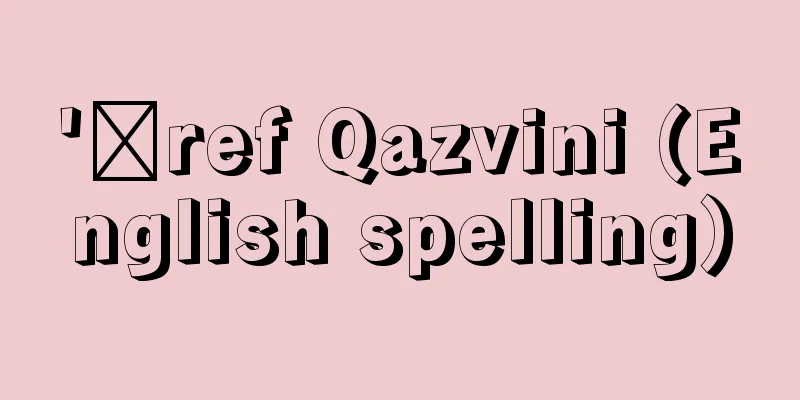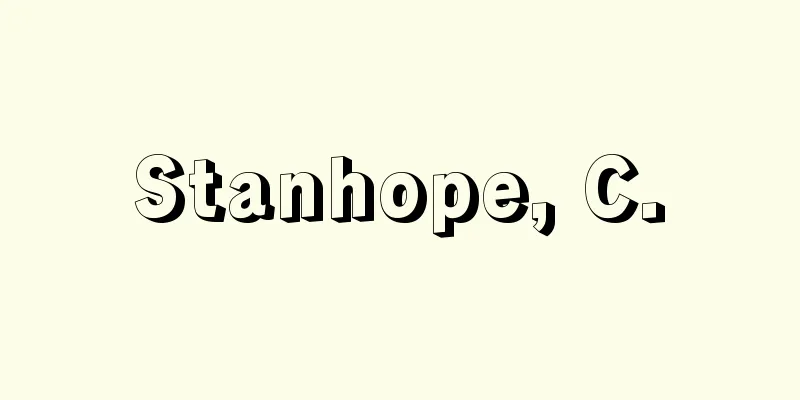Kanazoushi - Kanazoushi

|
It refers to prose works of some literary quality that were written and published during the 80 years between the Keicho period (1596-1615) in the early modern period and the publication of Saikaku's Koshoku Ichidai Otoko in 1682 (Tenwa 2). It is a successor to the Otogi-zoshi of the Middle Ages and is related to Saikaku's Ukiyo-zoshi. However, as an academic term, it is an ambiguous and incomplete name, and the word was recorded as early as the Muromachi period, and Saikaku's works were also called kana-zoshi at the time. The meaning of the word is simply a distinction between kana-hon and manna-hon (kanji-hon) by the use of characters. It is thought that the kana and soshi found in the classification of book catalogs compiled by publishing houses at the time fall under this category. In the end, it can be said to be entertainment and enlightening reading material written in hiragana, not academic books such as Chinese books, Buddhist scriptures, and medical books. Although some of these works were written in manuscript, they were widely circulated through publishing from the early modern period onwards, and therefore need to be considered under different conditions than traditional literary works. Very few authors of Kanazoshi are known. The majority are anonymous, and even if the work is fortunately signed or the author's name is listed in a bibliography, it is often impossible to find a biography. The authors are thought to have been ronin (masterless samurai), private scholars of Japanese classics, Chinese scholars, Buddhist monks, physicians, haiku poets, and so on. In the very early days, readers were the upper classes, but later, with the development of printing, the readership expanded to include the common people. In terms of the history of research, kana zoshi were first studied by Mizutani Futou, Fujioka Sakutaro and others in the latter half of the Meiji period, and this continues to this day. The works known as kana zoshi are extremely diverse in content, branching out in many directions and intersecting, so it was necessary to organize them in some way. Research has focused on classification, and before World War II, Ebara Taizo attempted to classify them, and after the war, Noda Hisao, Teruoka Yasutaka, Tanaka Shin and others did so. The following classification by Noda Hisao is considered appropriate. (1) Doctrine and moral teachings Asayama Mairin'an's "Kiyomizu Monogatari" (published in 1638) and Tsujihara Genpo's "Chie Kagami" (published in 1660). (2) Entertainment-oriented works: "Ada Monogatari" (published in 1640) by Miura Tameharu, and "Otogiboko" (published in 1666) by Asai Ryoi. (3) Practical works: "Kyowarabe" (published in 1658) by Nakagawa Kiun, and "Edo Meisho Ki" (published in 1662) by Asai Ryoi. Kanazoshi are of diverse types, and many of them have little literary value, so traditionally they have been viewed as transitional literature, and as a stepping stone in the study of Saikaku. Although there are many issues remaining, such as research on individual works, research on the author, and connections to the world around him, today there is a growing attitude of actively looking for the origins and embryonic seeds of early modern literature in general in the diverse character of kana zoshi, or in the foundations that supported kana zoshi, even if they are still immature. [Kouta Sakamaki] "Japanese Classical Literature Series 90: Kana Zoushi (1965, Iwanami Shoten), edited by Maeda Kingoro and Morita Takeshi " ▽ "Japanese Classical Literature Collection 37: Kana Zoushi and Ukiyo Zoushi (1971, Shogakukan), edited and translated by Jinbo Goya et al." ▽ "Appreciation of Japanese Classical Literature 26: Otogi Zoushi and Kana Zoushi (1976, Kadokawa Shoten), edited by Ichiko Sadatsugu and Noma Mitsutatsu" Volume 4 "Nanzenji" by Kiun Nakagawa, published in 1658 (Meireki 4), owned by the National Diet Library "Kyoto Children" Volume 1 "Nihonbashi" (Nihonbashi Bridge) by Ryoi Asai, published in 1662 (Kanbun 2), held at the National Diet Library "Records of famous places in Edo" Source: Shogakukan Encyclopedia Nipponica About Encyclopedia Nipponica Information | Legend |
|
近世初期の慶長(けいちょう)年間(1596~1615)から井原西鶴(さいかく)の『好色一代男』が刊行された1682年(天和2)までの約80年間に著作・刊行された、多少とも文学性の認められる散文作品で、中世の御伽(おとぎ)草子の後を受け、西鶴の浮世草子に接するものをいう。しかし学術用語としてはあいまい不完全な名称で、古く室町時代にこの語が記録にあり、また西鶴の作品をも当時は仮名草子と称していた。語の意味は、真名(漢字)本に対する仮名本という用字による区別にすぎない。当時の出版書肆(しょし)によって編集された書籍目録の分類にみられる仮名とか双紙とかいわれていたものがこれに該当すると考えられる。結局、漢籍仏典医書などの学術書でなく、平仮名で書かれた娯楽・啓蒙(けいもう)的な読み物といえよう。これらは写本で行われたものもあったが、近世初期以来の出版に取り上げられて多く流布した。したがって、従来の文学作品と異なった条件として考える必要がある。 仮名草子の作者はごくわずかしか知られていない。大部分が作者不詳であり、さいわい作品に署名があったり、書籍目録に作者名が記されていても、伝記を明らかにしえない場合が多い。作者層は、浪人・民間の国学者、漢学者、僧侶(そうりょ)、医師、俳諧(はいかい)師などであったと考えられる。読者は、ごく初期は上層階級であったが、のちに印刷術の発達とともに庶民階級にまで読者層が拡大した。 研究史としては、明治の後半期に水谷不倒(ふとう)、藤岡作太郎らによって仮名草子が研究対象として取り上げられ、今日に及んでいる。いわゆる仮名草子と称される作品群は、その内容がきわめて多種多様で多方面に分岐し交錯しているため、当然なんらかの整理を加える必要があった。そこで分類の作業を中心に研究が進められ、第二次世界大戦前は潁原(えばら)退蔵、戦後は野田寿雄(ひさお)、暉峻康隆(てるおかやすたか)、田中伸らによって分類が試みられた。次にあげる野田寿雄の分類などが妥当といえよう。(1)教義教訓的なもの 朝山意林庵(あさやまいりんあん)の『清水(きよみず)物語』(1638刊)、辻原元甫(つじはらげんぽ)の『智恵鑑(ちえかがみ)』(1660刊)。(2)娯楽的なもの 三浦為春の『あだ物語』(1640刊)、浅井了意の『御伽婢子(おとぎぼうこ)』(1666刊)。(3)実用本位のもの 中川喜雲の『京童(きょうわらべ)』(1658刊)、浅井了意の『江戸名所記』(1662刊)。 仮名草子は種類が多様多岐であり、内容も文学性の希薄なものが多いことから、従来は過渡期の文学ということで西鶴研究の階梯(かいてい)として付随的にみる傾向が強かった。作品個々の研究、作者の研究、周辺との関連など残された課題は多いが、今日ではむしろ、未成熟ではあるが仮名草子の多様な性格のなかに、あるいは仮名草子を支えた基盤のうちに、近世文学全般の源流や胎動萌芽(ほうが)を積極的にみていこうとする姿勢が定着しつつある。 [坂巻甲太] 『前田金五郎・森田武校注『日本古典文学大系90 仮名草子集』(1965・岩波書店)』▽『神保五彌他校注・訳『日本古典文学全集37 仮名草子集・浮世草子集』(1971・小学館)』▽『市古貞次・野間光辰編『鑑賞日本古典文学26 御伽草子・仮名草子』(1976・角川書店)』 4巻 「南禅寺」 中川喜雲著 1658年(明暦4)刊国立国会図書館所蔵"> 『京童』 巻1 「日本橋」 伝浅井了意著 1662年(寛文2)刊国立国会図書館所蔵"> 『江戸名所記』 出典 小学館 日本大百科全書(ニッポニカ)日本大百科全書(ニッポニカ)について 情報 | 凡例 |
<<: Canada - Kanada (English spelling) Canada
Recommend
Inorganic Acid - Muxan
Also called mineral acids. A term used in contras...
Rank - Ishi
This is a legal term used in the Nara and Heian pe...
Toho Co., Ltd.
A film and theater production, distribution, and e...
Bulb latest - Bulb latest
A small terrestrial orchid that rarely grows on th...
"Music Book Summary" - Gakusho Yorokuraku
…None of them are theoretical texts, but rather r...
Collection of Cloud Songs - Yun-yao-ji
A collection of poems from the Tang Dynasty in Chi...
Cyclamen neapolitanum
… [Munemin Yanagi]. … *Some of the terminology th...
The power of the keys
…In the late Middle Ages in Germany, after the ti...
Radioactive prospecting
Also known as radioactive exploration. It is a met...
Raw ore blowing - Namakoubuki
This was one of the smelting methods from the time...
Progressive muscular dystrophy
What is the disease? Muscle fiber Necrosis ( Repl...
Willigermus - Willigermus
…The upper exterior is surrounded by a gallery wi...
combatant ship
…The wartime hastily constructed anti-submarine a...
Index cycle
The difference between the average atmospheric pre...
Pekingese [species] (English spelling)
A pet dog originating from China. It was a breed t...









